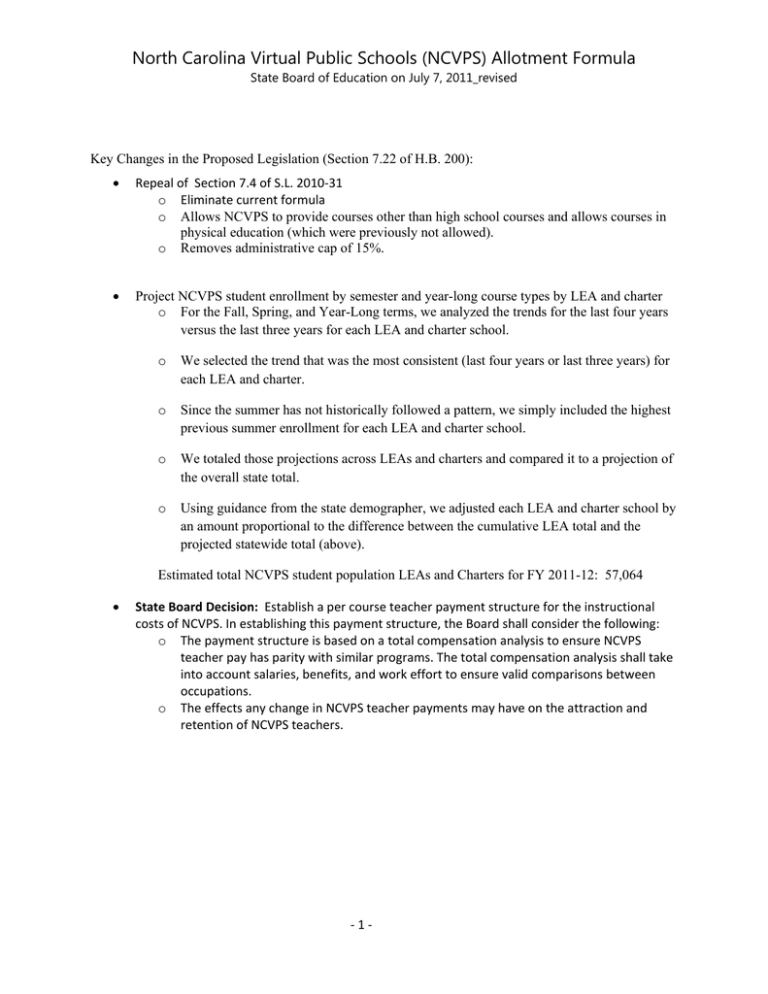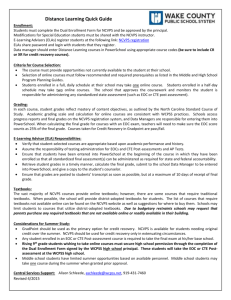North Carolina Virtual Public Schools (NCVPS) Allotment Formula
advertisement

North Carolina Virtual Public Schools (NCVPS) Allotment Formula State Board of Education on July 7, 2011_revised Key Changes in the Proposed Legislation (Section 7.22 of H.B. 200): • Repeal of Section 7.4 of S.L. 2010-31 o Eliminate current formula o Allows NCVPS to provide courses other than high school courses and allows courses in physical education (which were previously not allowed). o Removes administrative cap of 15%. • Project NCVPS student enrollment by semester and year-long course types by LEA and charter o For the Fall, Spring, and Year-Long terms, we analyzed the trends for the last four years versus the last three years for each LEA and charter school. o We selected the trend that was the most consistent (last four years or last three years) for each LEA and charter. o Since the summer has not historically followed a pattern, we simply included the highest previous summer enrollment for each LEA and charter school. o We totaled those projections across LEAs and charters and compared it to a projection of the overall state total. o Using guidance from the state demographer, we adjusted each LEA and charter school by an amount proportional to the difference between the cumulative LEA total and the projected statewide total (above). Estimated total NCVPS student population LEAs and Charters for FY 2011-12: 57,064 • State Board Decision: Establish a per course teacher payment structure for the instructional costs of NCVPS. In establishing this payment structure, the Board shall consider the following: o The payment structure is based on a total compensation analysis to ensure NCVPS teacher pay has parity with similar programs. The total compensation analysis shall take into account salaries, benefits, and work effort to ensure valid comparisons between occupations. o The effects any change in NCVPS teacher payments may have on the attraction and retention of NCVPS teachers. -1- North Carolina Virtual Public Schools (NCVPS) Allotment Formula State Board of Education on July 7, 2011_revised Recommendation: The estimated teacher payment per course (per student pay plus social security – see chart on the next page): Course Type Per-Student Pay Summer Fall Spring Year-Long $216 $330 $330 $419 Historical Average Students per Course 19 21 20 23 Estimated Course Teacher Payment $4,104 $6,930 $6,600 $9,637 The Fall salary corresponds to a teacher with a bachelor degree with 6 years of experience (assuming 5 courses being taught). • State Board Decision: Develop a per student fee structure for in-State students that is based on the per course teacher pay structure. The fee structure for in-State students shall ensure that the projected cost for local school administrative units and charter schools equals the projected instructional cost for NCVPS courses. Recommendation: The per course fees for FY 2011-12: Descriptor: Per Student Teacher Pay Apply Social Security (rounded Summer $200 Fall $306 (was $350 in Spring $306 (was $350 in Year-Long $390 (was $400 in FY 2010-11) FY 2010-11) FY 2010-11) $16 $24 $24 $29 $19 $19 $19 $19 $235 $349 $349 $438 up) Instructional Support * Total * Includes the estimated dollar amount per student (rounded) for foreign language conversation coaches ($225,000), instructional leaders ($565,000), and third party vendors ($350,000). • Multiply the per course fees for in-State students by the projected enrollment by course type to determine the total instructional cost for each local school administrative unit and charter school. • Transfer a dollar amount equal to seventy-five percent (75%) of the local school administrative unit's or charter school's projected instructional cost from the classroom teacher allotment to NCVPS. Recommendation: See the attached chart for estimated teacher positions to be reduced. • No later than February 21 of each year, calculate the actual instructional cost for each local school administrative unit and charter school based upon actual NCVPS enrollment as of that date. -2- North Carolina Virtual Public Schools (NCVPS) Allotment Formula State Board of Education on July 7, 2011_revised • o Subtract the amount transferred from the actual instructional cost for each unit or charter school and transfer the remaining dollar amount owed, up to a maximum of one hundred percent (100%) of the projected cost. o Develop and implement a policy regarding returning funds to local school administrative units and charter schools in cases where the amount transferred exceeds the actual instructional costs. The State Board of Education shall reduce each local school administrative unit's or charter school's classroom teacher allotment, or other allotment, as determined by the State Board of Education, on the basis of ADM in grades 6-12 to provide the sum of two million eight hundred sixty-six thousand nine hundred twenty-three dollars ($2,866,923) for the State-level operations and administration of NCVPS for the 2011-2012 fiscal year. The allotment reduction for Statelevel operations and administration shall continue in future fiscal years and be adjusted annually based upon the percentage growth in NCVPS enrollment, ensuring the expansion of services due to increased virtual student enrollment. Recommendation: Converts to $3.68 per grades 6-12 ADM. Reduce Non-Instructional Support. • For fiscal year 2011-2012, the State Board of Education shall reduce each local school administrative unit's or charter school's classroom teacher allotment, or other allotment, as determined by the State Board of Education, on the basis of ADM in grades 6-12 to provide the sum of two million dollars ($2,000,000) in order to create an NCVPS enrollment reserve. The NCVPS enrollment reserve shall be used to cover the NCVPS instructional costs of local school administrative units or charter schools with enrollments exceeding projected NCVPS enrollment. Recommendation: Converts to $2.57 per grades 6-12 ADM. Reduce Non-Instructional Support. Additional Decisions: o o Need to establish tuition for out-of-state students. NCVPS shall develop a plan to generate revenue by selling courses to out-of-state students, home-schooled students, and private school students. -3-



